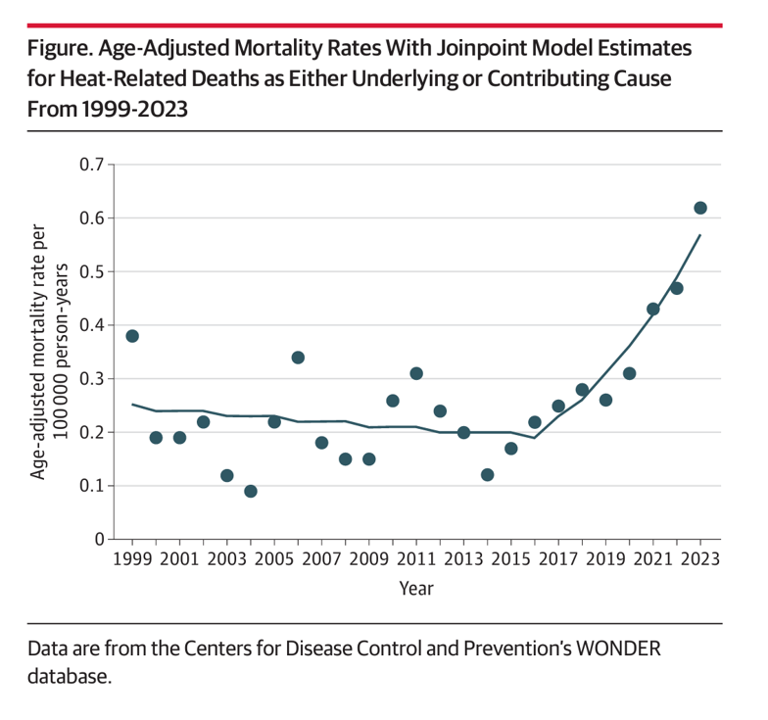Rising energy bills are confronting U.S. households (and indeed, health citizens in many parts of the world) due to extreme heat, PBS reported on 1st September.
But the record heat waves in so much of the world is impacting both peoples’ fiscal and financial well-being along with physical health impacts, ranging from exacerbating chronic respiratory conditions to, literally, risks to lives. 
A recent letter to JAMA, published August 26, 2024, quantifies Trends of Heat-Related Deaths in the U.S., 1999-2023.
The authors examined studies finding exposure to extreme heat associated with mortality, hypothesizing that heat-related mortality risks is globally increasing. They analyzed data from the U.S. CDC WONDER database and indeed found heat-related mortality rates in the U.S. increasing between 1999 and 2023, especially in the past seven years. This finding aligned with a global study in Nature Communications from 2023, warning that this trend would continue without short- and longer-term strategies to address “heat-flation” (more on that below.
“It’s official. Heat is now firmly on the agenda and in the public consciousness,” the World Economic recently observed. “The second of June was the first Heat Action Day, raising awareness of the detrimental impacts of extreme heat on lives and livelihoods after a report found that 26 days of the hottest 12 months on record were excess heat days likely due to climate change.”
This report supported a call-to-action termed “One Health.” That approach considers heat and climate in the context of inter-connected policies and inter-dependence of people, animals, and ecology, WEF explained. A One Health concept embeds health (in this case, climate change as a health driver), from health care to agriculture to physical built environments and fiscal/monetary policy. See the right sight of the WHO climate change graphic here for impacts on “expenses” — such as people and communities, infrastructure, energy systems, water systems and other investment line items.

On the physical health front, heat waves have expanded mosquito habitats leading to pollution-related and vector-borne diseases: think dengue, malaria, and Zika’s impacts on public health around the world. Excessive heat also drives up risks for people managing a range of chronic conditions: as detailed in the WHO “health outcomes” here, respiratory illness, non-communicable diseases (such as heart disease), and mental and psychosocial health, among other health and physical impacts.
Now, to the issue of “heat-flation,” The World Economic Forum addressed this in a video which explains the phenomenon of rising food prices directly caused by extreme heat — one of the fiscal dimensions of the heat crisis impacting food systems around the world. “Heatwaves are damaging and destroying crops around the world, and as the supply of food dwindles, prices begin to climb,” WEF asserted.

Health Populi’s Hot Points: Here’s a snapshot of “now” and climate/heat events around the world in July 2024. Thanks to the smart folks at NOAA, the National Oceanic and Atmospheric Administration, an agenda of the U.S. Department of Commerce.
Here NOAA identifies a dozen+ “climate anomalies” throughout the world, from the Arctic and North America to Oceania and Europe and the Antarctic — together, painting a picture of the warmest temperatures recorded since global records began in 1850 — which NOAA says is the 14th consecutive record-warm month.
That NOAA is part of the Department of Commerce speaks to one (significant) dot for a One Health public policy approach to climate change and public health. The data forming the line chart, above, by the JAMA letter researchers Howard, Androne, Alcover, and Santos-Lozada, connect other dots on year-on-year increases in heat in the U.S., contributing to excess mortality. Excess heat is extracting costs across all aspects of health and well-being throughout the world across all health citizens. Every stakeholder in the health/care industry and all private sector organizations indeed have roles to play to address this challenge both in the immediate and longer-term.





 Grateful to Gregg Malkary for inviting me to join his podcast
Grateful to Gregg Malkary for inviting me to join his podcast  This conversation with Lynn Hanessian, chief strategist at Edelman, rings truer in today's context than on the day we recorded it. We're
This conversation with Lynn Hanessian, chief strategist at Edelman, rings truer in today's context than on the day we recorded it. We're